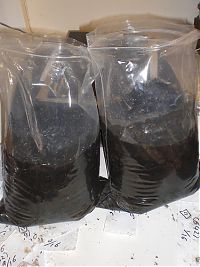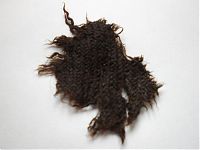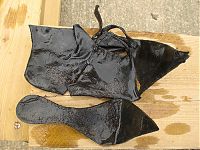Archaeology isn't treasure hunting....oh, er actually...
- By: Steve Campion |
- Jul 31, 2008
- Share
- del.icio.us

Sample 11 is finished. For most of you that will mean nothing. For others, namely co-workers who have suffered my moans, it may possibly mean something (albeit, with a healthy dollop of confusion and a smattering of nonchalance). For me however, this is happy news. You see, sample 11 took ages to process, all due to artefact retrieval.
The context was noted to contain leather, so a large sample was taken in order to retrieve this. 160 litres to be precise.
40 litres of this were processed in the normal way, with a light and heavy fraction being taken for assessment. The remaining 120 litres was then wet sieved for artefacts. This is a simple process really. Wash away the dirt and retrieve only the artefacts. Well, simple yes, but when you’re dealing with a large assemblage of tiny offcuts of leather then simple soon becomes time consuming. To be honest though, I loved this sample. Yes, it was a nightmare to go through the tank as it turned the water to thick black filth by merely a glance; yes, it was four times bigger than a normal sample and yes, it took forever to extract every piece of leather, but a nice sample like this is rare and really makes you appreciate just how great it is to be working on a site like Prescot Street. I mean, as well as the masses of leather and pottery (yawn), there were some really lovely finds such as a near intact shoe/boot, three nice wooden pegs and a small fragment of textile (approx. an inch square).
Why is all this great? Well, normally, organic products such as wood, leather and cloth wouldn’t survive being in the ground for such a period of time. However, this sample was waterlogged, which means that the context was saturated with water. In as simple terms as I can put this without going into chemistry; this prevents the air from entering the soil which preserves the perishable objects since oxygen is the primary contributor towards decay.
So once out of the sample, the perishable finds must remain wet. Leaving them to dry out would cause all kinds of problems. The next step for these items is conservation, which I’m sure will be discussed in a blog in the not too distant future. So for those of you that love your chemistry look out for that.
All in all, this is a very exciting sample. Right, I’m off to flot (not a spelling mistake) to see what else is out there. The Ark of the Covenant would be nice. As would be a Crystal Skull to throw at George Lucas’s face in penance for ruining an iconic series. Bitter? No. We’re just archaeologists who are trained how to find bodies. Hiding them are easy…….you hear that George?
burials, 61 Photos
- (0)



















![Pit [1873]](http://farm4.static.flickr.com/3176/2859280346_01ae9c4ff8_s.jpg)

















![Remnants of the Ring Ditch [1770]](http://farm4.static.flickr.com/3110/2859253242_a6147bc8a2_s.jpg)









![Wide shallow pit [1829]](http://farm4.static.flickr.com/3074/2858411321_918c2c87e6_s.jpg)







![Cut of Cremation Burial [1856]](http://farm4.static.flickr.com/3099/2858401159_9c5efbdb53_s.jpg)

![Grave Cut [1835]](http://farm4.static.flickr.com/3101/2859228672_984ef4819c_s.jpg)
![Cut [1801] of Cremation Burial](http://farm4.static.flickr.com/3290/2859227766_18c680b2f3_s.jpg)

![Grave Cut [1832]](http://farm4.static.flickr.com/3069/2858395937_e39de4a550_s.jpg)
![Shallow Pit [1844]](http://farm4.static.flickr.com/3242/2859224408_54f2c55e24_s.jpg)

